This recipe for Low FODMAP Pizza 2.0, which makes 2 crusts, is for those who are willing to put a little more effort into their pizza making process. For our simplest low FODMAP pizza recipe, click on over to our Easy Low FODMAP Pizza, and definitely read our article, Everything You Need To Know About Low FODMAP Pizza. That’s our main hub of all things pizza! This recipe does require specialized equipment and ingredients; read on.
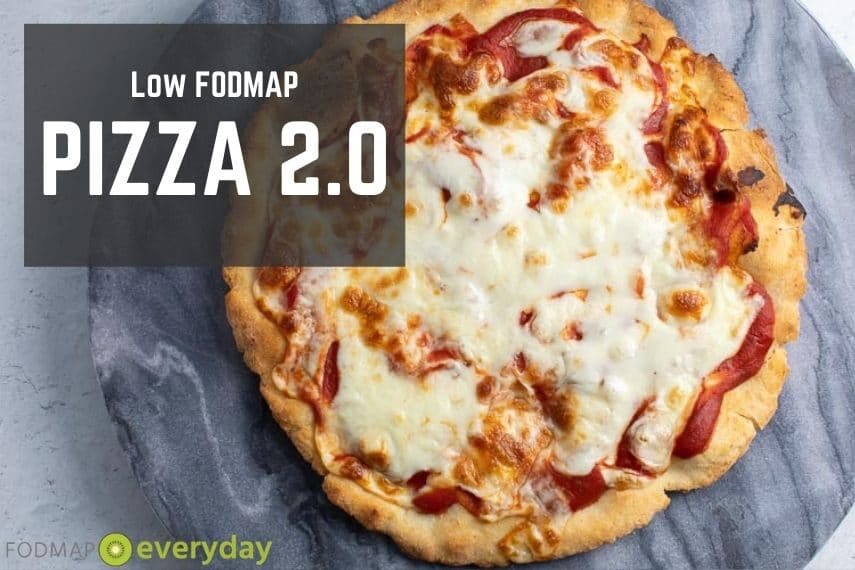
Plan Ahead
For this recipe you need Better Batter flour, which contains pectin, as well as Expandex, which is modified tapioca starch. Both are low FODMAP and give this pizza the perfect chew. We also recommend using a ceramic pizza stone or baking steel. And when I say recommend, I really mean that if you want your pizza to come out like the ones in the images – you NEED them, preferably the baking steel. All the info is below. You might have to order some of these items online, so plan ahead.
For more in-depth generalized information on ingredients and equipment be sure to read Low FODMAP Pizza Ingredients & Equipment.
Because people love pizza and that includes FODMAPers. Some folks want to spend as little time in the kitchen as possible, while still being able to make a homemade pizza. Others love investing in equipment and specialty ingredients to make their gluten-free pizza the best it can be; sometimes you want to make pizza on the grill, and then there are times you want deep-dish! We want to offer pizza recipes for all of you.
Yes, they are! They were developed with the specific needs and wants described in their headnotes. They use different ingredients, different preparation and cooking techniques and call for different equipment. What makes a pizza great is somewhat subjective, but some parts are generally accepted. In my opinion, our easiest pizza is not our “best”, but I understand that some folks will not want to venture beyond that approach. This Low FODMAP Pizza 2.0 recipe below is a step up from our easiest. It produces those desirable blisters and char on the crust, providing you use the recommended ingredients and equipment.
Yes, you do. This recipe works when it is made as written – with the specified ingredients and techniques. For a simpler pizza crust, try our Easy Low FODMAP Pizza.
This gluten-free flour blend, which also happens to be low FODMAP, contains xanthan gum and the addition of pectin. Bob’s Red Mill Gluten Free 1 to 1 Baking Flour and King Arthur Gluten Free Measure For Measure Flour, to name just two others, also contain xanthan, but the addition of pectin in the Better Batter works magic in certain gluten-free baked goods.
I call for Better Batter flour in our Cinnamon Buns and Caramel Pecan Rolls, too. The pectin provides a chewiness and a better texture than any other flour. Do not substitute another flour.
Then we suggest that you make a DIY version, or choose another pizza recipe that does not call for this flour.
Because every time we have investigated creating one, the cost of gathering all of the individual ingredients made it a very expensive proposition. And because the one we have linked to HERE is a very good copycat recipe.
You could, but I have no way of guaranteeing that your pizza will turn out well. Why take such a chance on wasting all your time, expense and effort?
Expandex is made from modified tapioca starch and is gluten-free and non-GMO. It improves the texture and moisture retention in gluten-free baking, is essentially flavorless and can enhance the overall quality of certain low FODMAP and gluten-free recipes.
Expandex is regular tapioca starch with a modified cellular composition that gives it the uniques qualities we need for this recipe. It is non-GMO. Tapioca starch, by the way, is made from cassava root, but it is not the same as cassava flour.
Yes, and I will give you the instructions below, along with my preferred method of using a stand mixer.
I do not recommended that you make this dough ahead, although you will see this recommended on other websites. I refrigerated this dough during testing for up to 3 days and I did not like the way it cooked up at all. The pectin in the dough appears to have a deleterious effect on the dough if it’s refrigerated for a prolonged time, resulting in doughy, uncooked centers, no matter how I adjusted the oven temperature.
Yes, you do. There are two kinds: wood and metal. Wooden pizza peels are usually used to “launch” raw pizzas into the oven. Metal ones, with their nice thin, sharp edge, are typically used to retrieve finished pizzas from a hot oven. If you only buy one, get the metal one, which is more versatile. Caveat: Some folks think raw pizza dough sticks more to the metal and that makes it more difficult to launch into the oven. If you have flour or cornmeal on your peel, I have not found this to be the case.
We have recipes, such as our Easy Low FODMAP Pizza, which is made on a common heavy-duty aluminum half-sheet pan. These pans are very useful and are our top choice for cookies, large batch bars, roasting vegetables and making sheet pan meals. But they can only conduct so much heat. Ceramic pizza stones conduct more heat and help crisp up your pizza bottoms in a way that an aluminum sheet pan cannot. There are also baking steels, which conduct heat way better than any ceramic stones. You can read more in our article on ingredients and equipment specific to pizza.
Yes, these are additional items to buy. It all depends on how much you are willing to invest on pizza making.
Here’s the deal:
1. Pizza dough baked on conventional cookie sheet pans will be okay, and often better than store-bought.
2. Pizza doughs baked on preheated cookie sheet pans will be marginally better.
3. Pizza dough baked on preheated ceramic pizza stones will be better than any pizza baked on an aluminum baking sheet pan.
4. Pizzas baked on a preheated baking steel will be Much better than the same pizza baked in any of the preceding manners.
So, if you have trouble getting your pizza bottoms golden brown and/or spotted with crispy areas and sporting enticing raised bubbles on top, then I highly suggest you invest in a baking steel if you can, and if that is too much of an investment, then get a pizza stone (although good stones are pricey, too).
Personally, if I am going to take the time to make low FODMAP pizza dough from scratch, I am going to bake it on a baking steel that I have preheated for 1 hour. Having repeatedly seen the quality between crusts baked on baking sheet pans, ceramic stones and baking steels, I will choose the baking steel every time.
The only better way to make pizza is in a very high temperature pizza oven. For more on that approach, check out our recipe for Wood-Fired Neapolitan-Style Low FODMAP Pizza. Of course, I love Grilled Pizza, too, but I put that in a class by itself.
You could…but you would need two pizza stones or baking steels – and I wasn’t going to ask that of you. If you do have the equipment, here is what I have learned: place the racks in the two hottest areas of the oven and make sure your stones or baking steels are preheated for a full hour. And, one pizza always comes out better than the other – every damn time.
Yes. I know that’s not how they do it in most pizzerias, but they have ovens that get to 800°F to 900°F (427°C to 482°C). Also, pizzerias are not typically baking gluten-free crusts that are housemade from scratch. Instead, most pizzerias offer gluten-free crusts that are purchased pre-baked from an outside source.
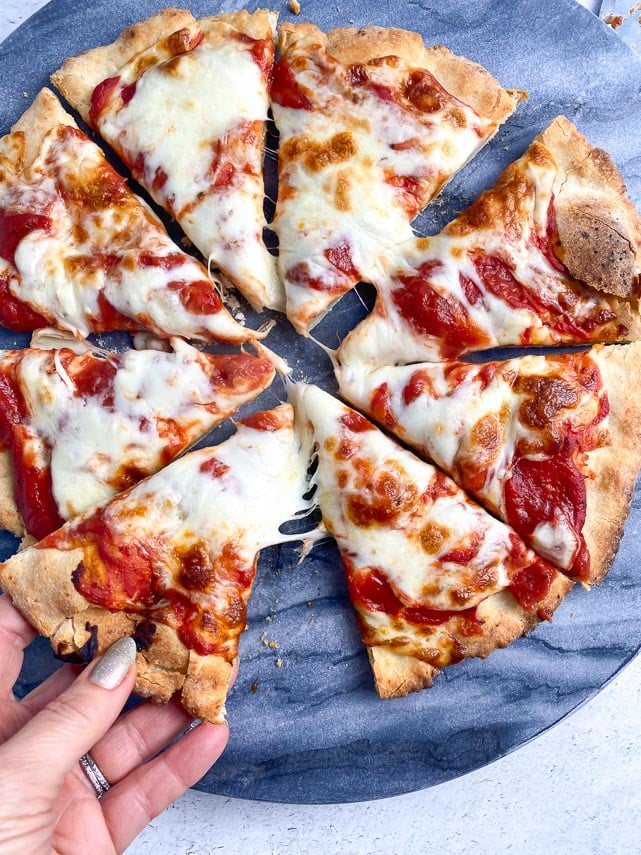
Ingredients
As stated above, you do need to purchase some very specific ingredients for this pizza – most notably the Better Batter Flour, Expandex and xanthan gum (all of which are low FODMAP). Please do not try and make this recipe without them.
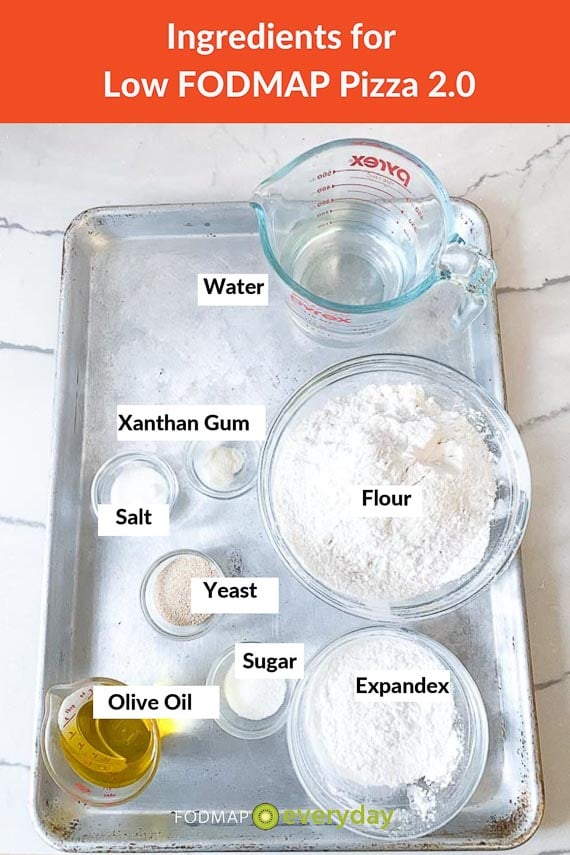
How To Make Low FODMAP Pizza 2.0
For Making By Hand: Whisk together 2 ⅓ cups flour, Expandex, instant yeast, salt, sugar and xanthan gum in a large bowl to aerate and combine.
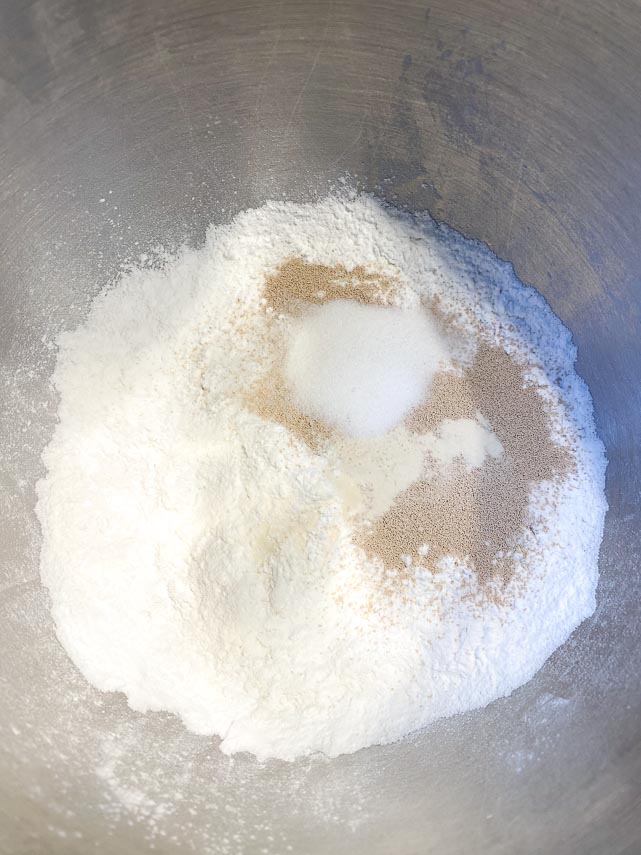
Add the warm water, ⅓ cup (75 ml) olive oil and begin to stir together with a sturdy wooden spoon until a wet dough forms, then beat vigorously until mixture looks like a soft, somewhat wet batter with a little elasticity.
For Making With A Stand Mixer: Place 2 ⅓ cups flour, Expandex, instant yeast, salt, sugar and xanthan gum in stand mixer bowl fitted with flat paddle attachment and mix on low to aerate and combine. Add the warm water, ⅓ cup (75 ml) olive oil and mix on low-medium speed until a wet dough forms, then turn speed up to medium to medium-high and beat until mixture looks like a soft, somewhat wet batter with a little elasticity.
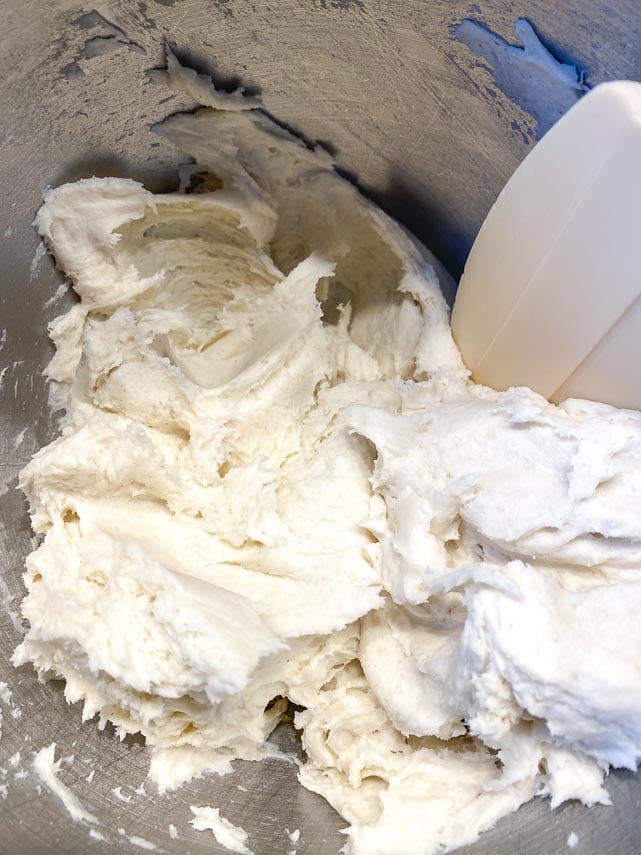
Transfer the dough to an oiled container with a tight-fitting lid, or a greased bowl. Coat the dough lightly with olive oil and cover tightly with lid or with plastic wrap over bowl. Place in a warm, draft-free area to rise for 1 ¼ hours.
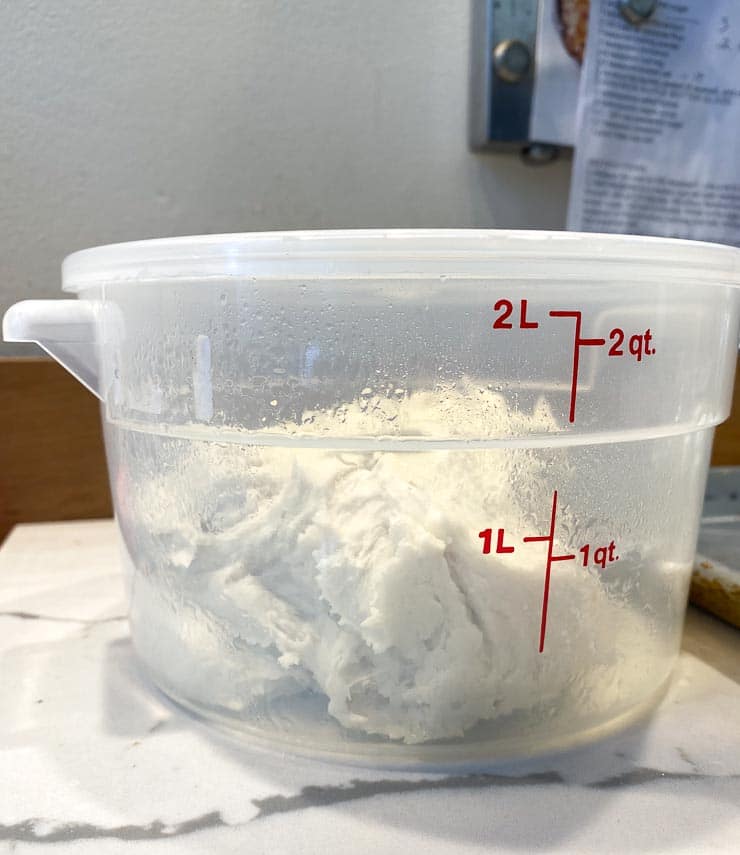
About halfway through this rising period position oven rack in hottest area of oven and place your ceramic pizza stone or baking steel on the rack. Preheat oven to 450°F (230°C). You want your stone or steel to preheat for about an hour before you launch your pizza onto it.
Meanwhile, prep your sauce and toppings. The Pizza Sauce should be room temperature, or at least not cold.
After 1 ¼ hours the dough should have risen and look quite expanded and puffy, not quite doubled in volume.
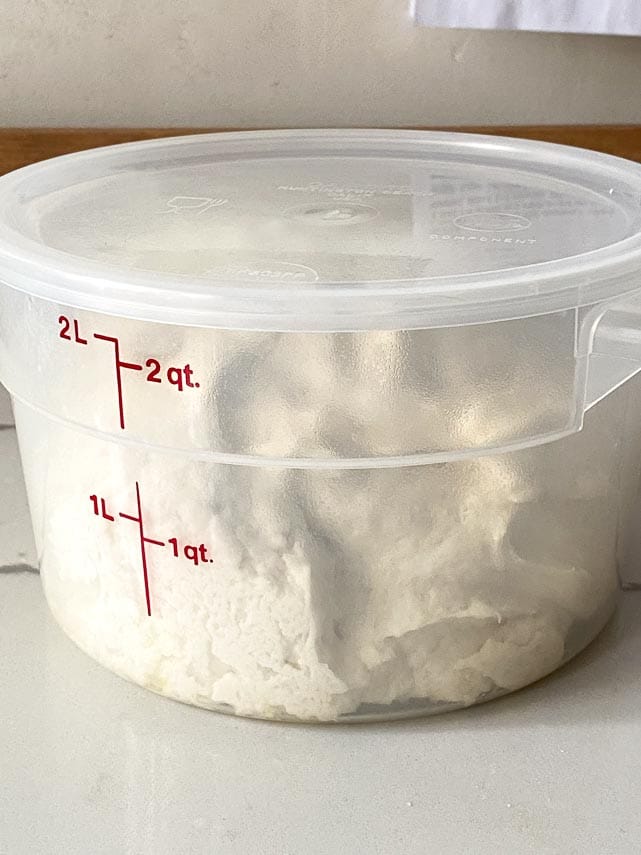
Remove dough from container or remove plastic wrap and place the dough on a lightly floured surface; sprinkle a little flour on top, too and lightly coat your fingers.
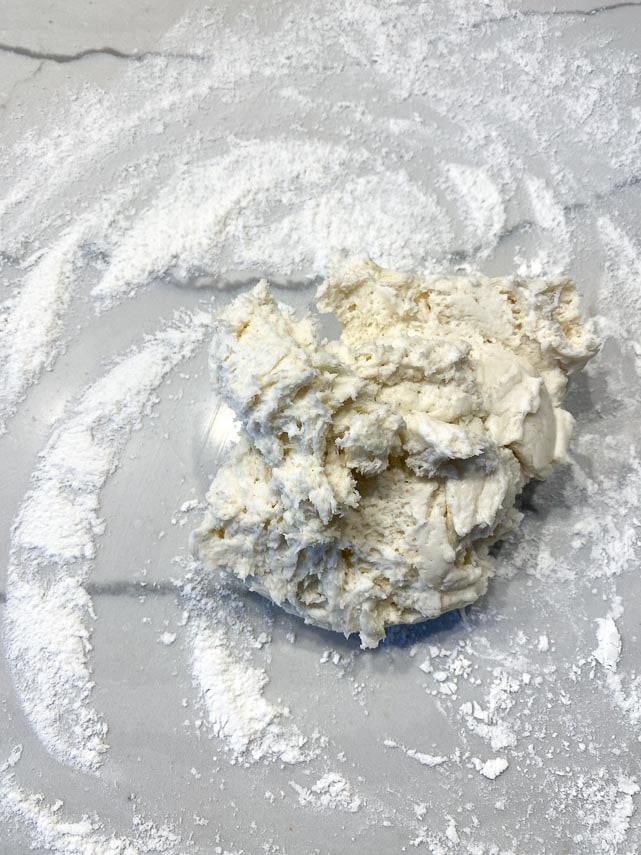
Knead the dough by hand a little bit until it is smooth then divide in half. Cover the unused half with plastic while you work with the first half.
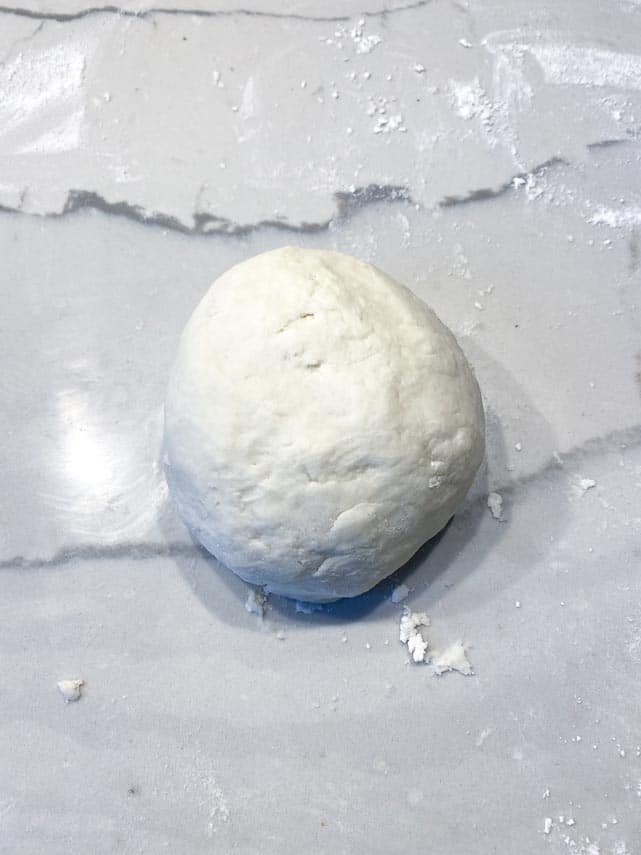
Shape the dough into a smooth ball, then roll out the first dough ball on a lightly floured surface with a lightly floured coated rolling pin to about a 10-inch (25 cm) diameter, or pat out with floured fingers. Move the dough around frequently to prevent sticking and use a little extra flour as needed. Create a slightly raised edge around the perimeter.
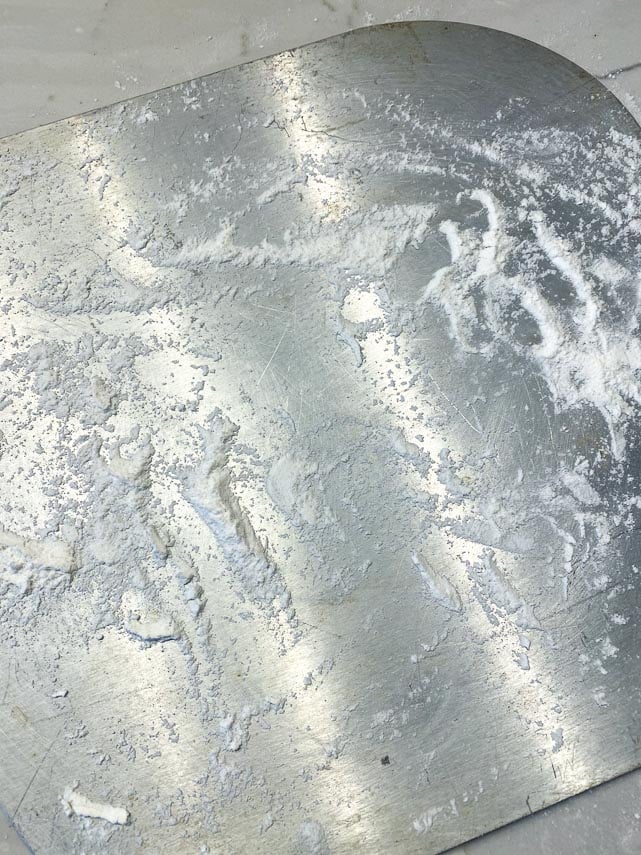
Dust a pizza peel with flour, slide the pizza crust onto the peel, brush the top with olive oil.
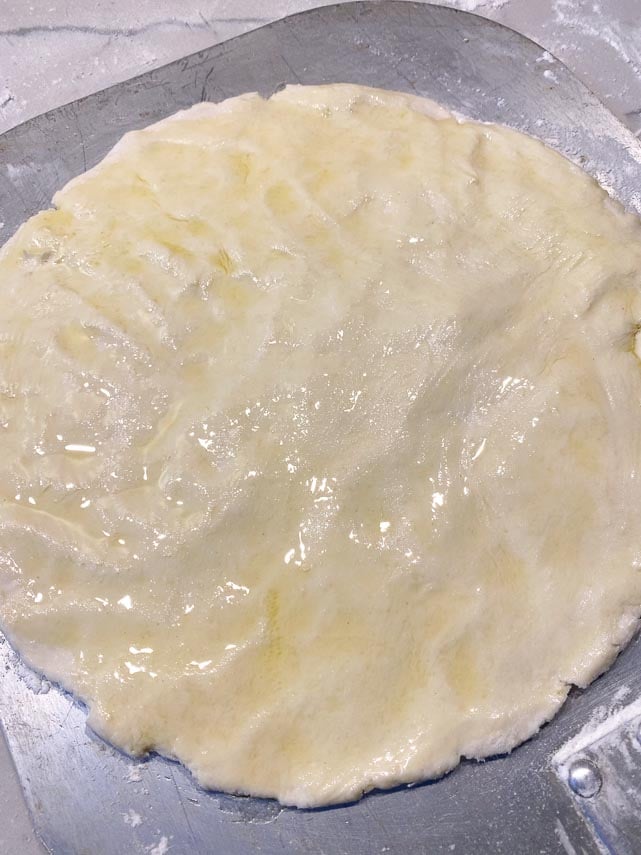
Launch the pizza onto the preheated stone or baking steel in the oven. Bake for about 6 to 8 minutes or so until the bottom begins to color and crisp up. The crispness is more important than the time. It is okay if some bubbles form on top.
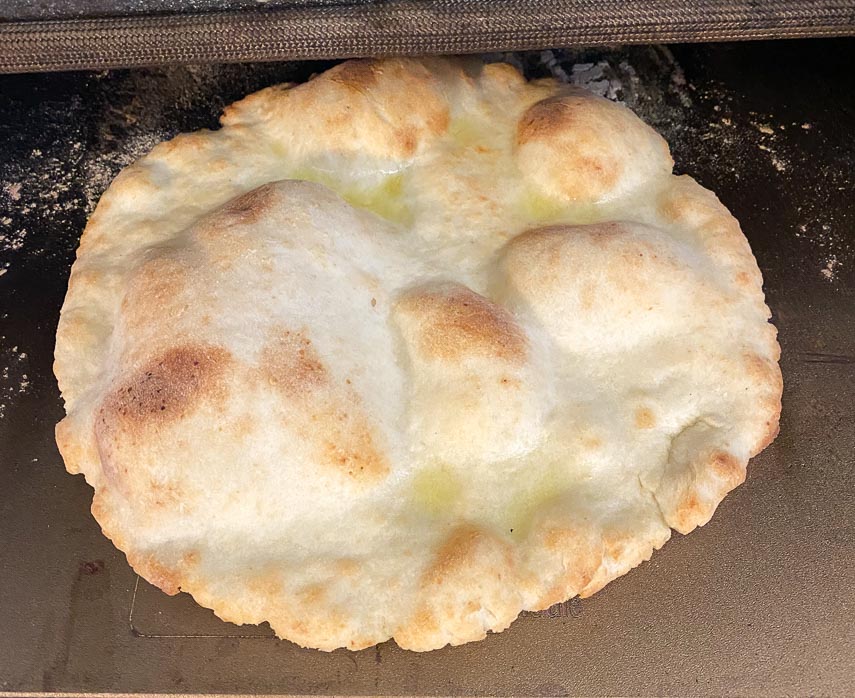
(At this point, the crust is par-baked and can be cooled, wrapped tightly in plastic wrap, slipped into a large zip top bag and frozen for one month. If freezing, defrost at room temperature and continue with the recipe as follows).
To Finish Pizza: Quickly remove pizza crust from oven with pizza peel. Close oven door so that the oven retains heat. Brush the edges of the crust with extra olive oil then spread about ½ cup (125 g) of sauce over crust, leaving about a half an inch border of crust. Scatter cheese and any toppings over the sauce.
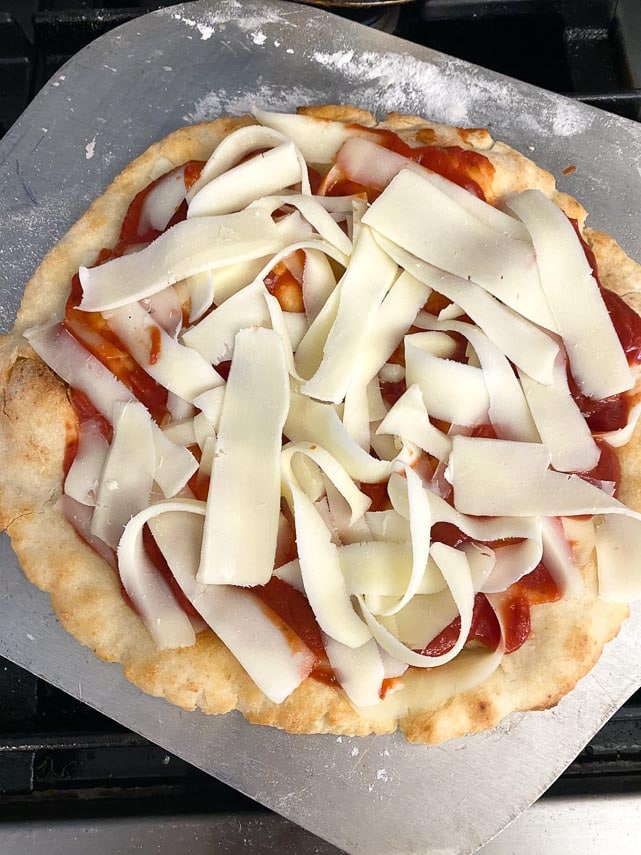
Re-launch the pizza onto stone or steel and bake for about 6 to 8 minutes or until cheese is melted and beginning to bubble and crust is browned and crisp.
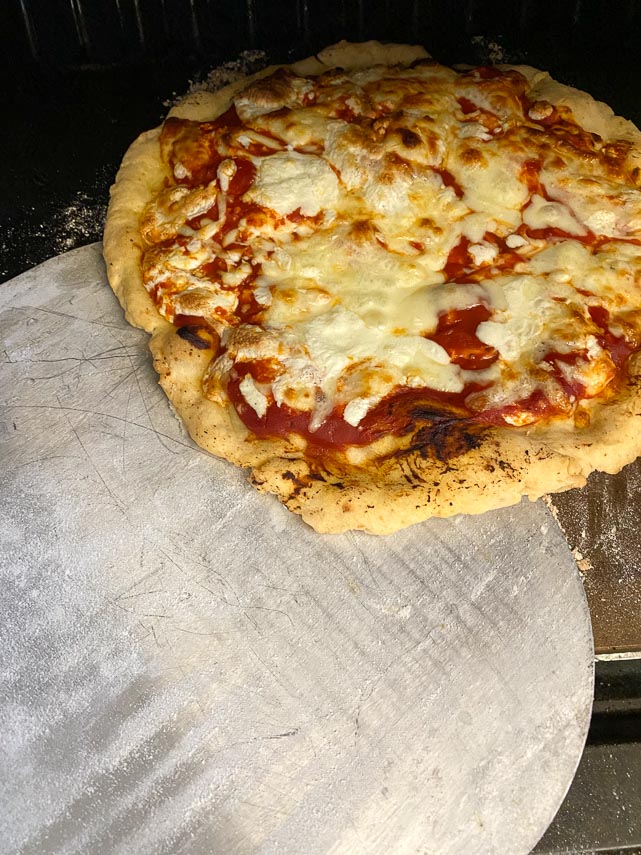
Serve immediately. Now repeat for second pizza.
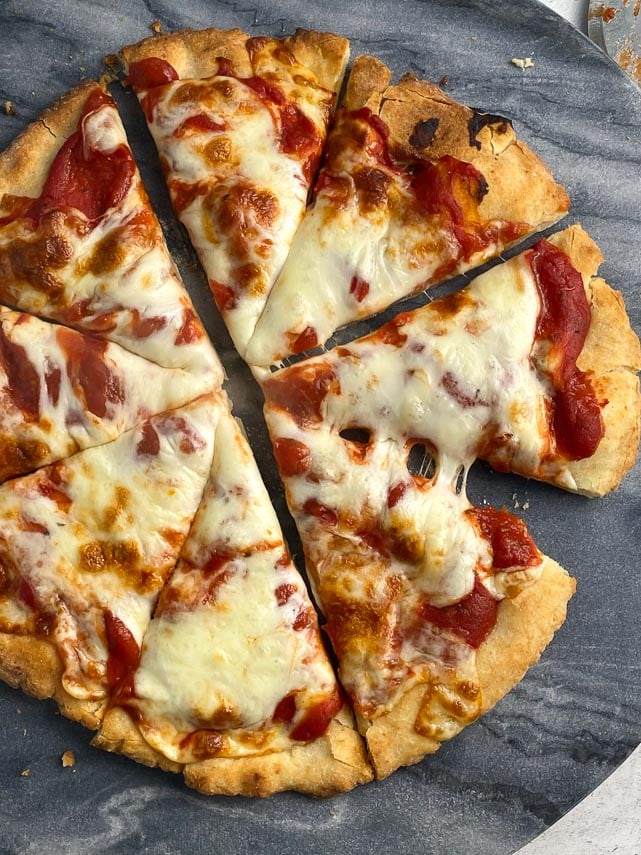
More Gluten-Free Pizza Recipes
Not all of our pizza recipes are gluten-free, but several, in addition to this one, are. Here is our list of Gluten-Free Pizza Recipes.
- Low FODMAP Easy Pizza
- Caputo Fioreglut Low FODMAP Pizza
- Low FODMAP Deep-Dish Pizza
- Low FODMAP Grilled Pizza
- And this one, our 2.0 recipe.
FODMAP Information
Our recipes are based on Monash University and FODMAP Friendly science.
- Canned Tomatoes: Monash University has lab tested canned tomatoes and they are low FODMAP at 92 g or 3.2-ounces, which they say is about ⅗ of a cup. Moderate FODMAPs kick in at about ¾ cup or 115 g, at which point fructose can become an issue.
- Cheese: Many cheeses have low FODMAP serving sizes. The low FODMAP diet is not a dairy-free diet. Hard cheeses such as Parmigiano Reggiano or Pecorino Romano have been lab tested by Monash University and are low FODMAP in 40 g amounts.
- Oil: All pure oils are fats and contain no carbohydrates, therefore they contain no FODMAPs.
- Sugar: Monash University and FODMAP Friendly have both lab tested white, granulated sugar. Monash states that a Green Light low FODMAP serving size of white sugar is ¼ cup (50 g). FODMAP Friendly simply states that they have tested 1 tablespoon and that it is low FODMAP. Regular granulated white sugar is sucrose, which is a disaccharide made up of equal parts glucoseand fructose. Sucrose is broken down and absorbed efficiently in the small intestine.
- Tomatoes: Both Monash University and FODMAP Friendly have lab tested common, beefsteak tomatoes. Monash University lab tests have shown no FODMAPs. FODMAP Friendly gives them a “Pass” at ½ cup (75 g) portions. Cherry tomatoes and Plum (Roma) tomatoes have also been tested by Monash and FODMAP Friendly. Both Monash and FODMAP Friendly recommend 75 g of cherry tomatoes as a serving (about 5 or ½ cup) and 75 g of plum or Roma tomatoes, which is about 1 small tomato or ½ cup.
- Yeast: Yeast – fresh, dry and instant – are all low FODMAP.
Please always refer to the Monash University & FODMAP Friendly smartphone apps for the most up-to-date lab tested information. As always, your tolerance is what counts; please eat accordingly. The ultimate goal of the low FODMAP diet is to eat as broadly as possible, without triggering symptoms, for the healthiest microbiome.
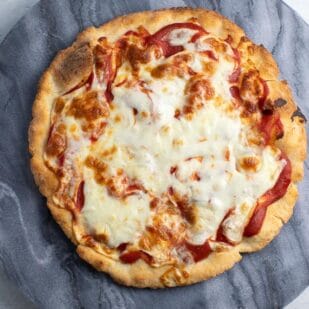
Low FODMAP Pizza 2.0
This recipe for Low FODMAP Pizza 2.0 is for those who are willing to put a little more time, money and effort into their pizza making process. For this recipe you need Better Batter flour, which contains pectin, as well as Expandex, which is modified tapioca starch. Both are low FODMAP and give this pizza the perfect chew. We also recommend using a ceramic pizza stone or baking steel.
Low FODMAP Serving Size Info: Makes 2, 10-inch to 11-inch (25 cm to 28 cm) pizzas; we suggest 4 servings total, but it will depend on toppings
Ingredients:
Pizza Dough:
- 2 1/3 cups (385 g) Better Batter Flour, plus extra
- ¼ cup (36 g) Expandex
- 1 tablespoon instant yeast, such as SAF brand red label
- 1 ½ teaspoons sugar
- 1 teaspoon salt
- ¼ teaspoon xanthan gum
- 1 ¼ cups (300 ml) plus 1 tablespoon warm water, 120°F to 125°F (48°C to 52°C)
- 1/3 cup (75 ml) extra-virgin olive oil, plus extra
Toppings & Sauce:
- 1 cup (240 g) Low FODMAP Pizza Sauce
- 8- ounces (225 g) shredded or thinly sliced low-moisture mozzarella
- Low FODMAP pepperoni
- Sautéed red or green peppers or oyster mushrooms
- Other low FODMAP toppings
- Fresh basil leaves; optional – to be added after baking
Preparation:
-
For Making By Hand: Whisk together 2 ⅓ cups flour, Expandex, instant yeast, salt, sugar and xanthan gum in a large bowl to aerate and combine. Add the warm water, ⅓ cup (75 ml) olive oil and begin to stir together with a sturdy wooden spoon until a wet dough forms, then beat vigorously until mixture looks like a soft, somewhat wet batter with a little elasticity.
-
For Making With A Stand Mixer: Place 2 ⅓ cups flour, Expandex, instant yeast, salt, sugar and xanthan gum in stand mixer bowl fitted with flat paddle attachment and mix on low to aerate and combine. Add the warm water, ⅓ cup (75 ml) olive oil and mix on low-medium speed until a wet dough forms, then turn speed up to medium to medium-high and beat until mixture looks like a soft, somewhat wet batter with a little elasticity.
-
Transfer the dough to an oiled container with a tight-fitting lid, or a greased bowl. Coat the dough lightly with olive oil and cover tightly with lid or with plastic wrap over bowl. Place in a warm, draft-free area to rise for 1 ¼ hours.
-
About halfway through this rising period position oven rack in hottest area of oven and place your ceramic pizza stone or baking steel on the rack. Preheat oven to 450°F (230°C). You want your stone or steel to preheat for about an hour before you launch your pizza onto it.
-
Meanwhile, prep your sauce and toppings. Pizza Sauce should be room temperature, or at least not cold.
-
After 1 ¼ hours the dough should have risen and look quite expanded and puffy, not quite doubled in volume. Remove dough from container or remove plastic wrap and place the dough on a lightly floured surface; sprinkle a little flour on top, too and lightly coat your fingers. Knead the dough by hand a little bit until it is smooth then divide in half. Cover the unused half with plastic while you work with the first half.
-
Form dough into a smooth ball, then roll out on a lightly floured surface with a lightly floured coated rolling pin to about a 10-inch (25 cm) diameter, or pat out with floured fingers (that’s what I do). Move the dough around frequently to prevent sticking and use a little extra flour as needed. Create a slightly raised edge around the perimeter.
-
Dust a pizza peel with flour, slide the pizza crust onto the peel, brush the top with olive oil and launch the pizza onto the preheated stone or baking steel in the oven.
-
Bake for about 6 to 8 minutes or so until the bottom begins to color and crisp up. The crispness is more important than the time. It is okay if some bubbles form on top.
-
(At this point, the crust is par-baked and can be cooled, wrapped tightly in plastic wrap, slipped into a large zip top bag and frozen for one month. If freezing, defrost at room temperature and continue with the recipe as follows).
-
To Finish Pizza: Quickly remove pizza crust from oven with pizza peel. Close oven door so that the oven retains heat. Brush the edges of the crust with extra olive oil then spread about ½ cup (125 g) of sauce over crust, leaving about a half an inch border of crust. Scatter cheese and any toppings over the sauce. Re-launch bake onto stone or steel and bake for about 6 to 8 minutes or until cheese is melted and beginning to bubble and crust is browned and crisp. Serve immediately. Now repeat for second pizza.
Notes:
FODMAP Information
Our recipes are based on Monash University and FODMAP Friendly science.
- Canned Tomatoes: Monash University has lab tested canned tomatoes and they are low FODMAP at 92 g or 3.2-ounces, which they say is about ⅗ of a cup. Moderate FODMAPs kick in at about ¾ cup or 115 g, at which point fructose can become an issue.
- Cheese: Many cheeses have low FODMAP serving sizes. The low FODMAP diet is not a dairy-free diet. Hard cheeses such as Parmigiano Reggiano or Pecorino Romano have been lab tested by Monash University and are low FODMAP in 40 g amounts.
- Oil: All pure oils are fats and contain no carbohydrates, therefore they contain no FODMAPs.
- Sugar: Monash University and FODMAP Friendly have both lab tested white, granulated sugar. Monash states that a Green Light low FODMAP serving size of white sugar is ¼ cup (50 g). FODMAP Friendly simply states that they have tested 1 tablespoon and that it is low FODMAP. Regular granulated white sugar is sucrose, which is a disaccharide made up of equal parts glucose and fructose. Sucrose is broken down and absorbed efficiently in the small intestine.
- Tomatoes: Both Monash University and FODMAP Friendly have lab tested common, beefsteak tomatoes. Monash University lab tests have shown no FODMAPs. FODMAP Friendly gives them a “Pass” at ½ cup (75 g) portions. Cherry tomatoes and Plum (Roma) tomatoes have also been tested by Monash and FODMAP Friendly. Both Monash and FODMAP Friendly recommend 75 g of cherry tomatoes as a serving (about 5 or ½ cup) and 75 g of plum or Roma tomatoes, which is about 1 small tomato or ½ cup.
- Yeast: Yeast – fresh, dry and instant – are all low FODMAP.
Please always refer to the Monash University & FODMAP Friendly smartphone apps for the most up-to-date lab tested information. As always, your tolerance is what counts; please eat accordingly. The ultimate goal of the low FODMAP diet is to eat as broadly as possible, without triggering symptoms, for the healthiest microbiome.
Nutrition
All nutritional information is based on third-party calculations and should be considered estimates. Actual nutritional content will vary with brands used, measuring methods, portion sizes and more. For a more detailed explanation, please read our article Understanding The Nutrition Panel Within Our Recipes.
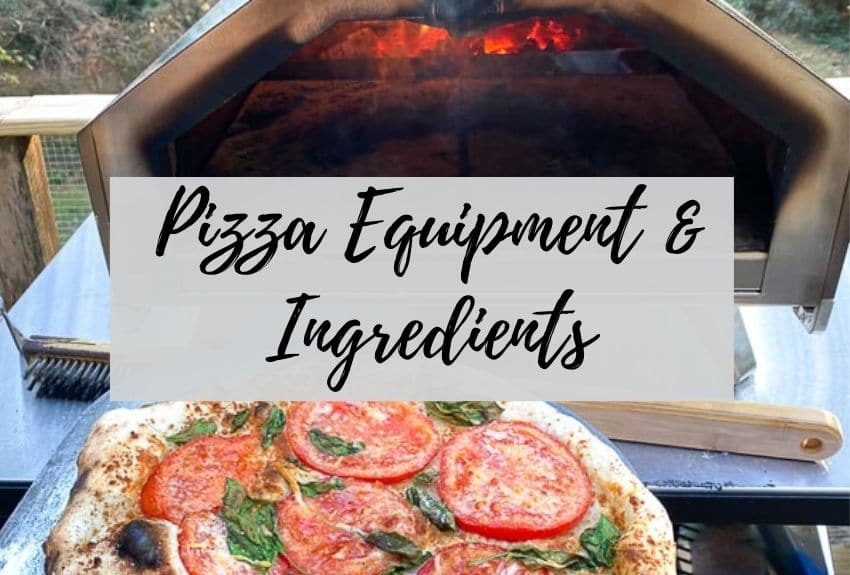
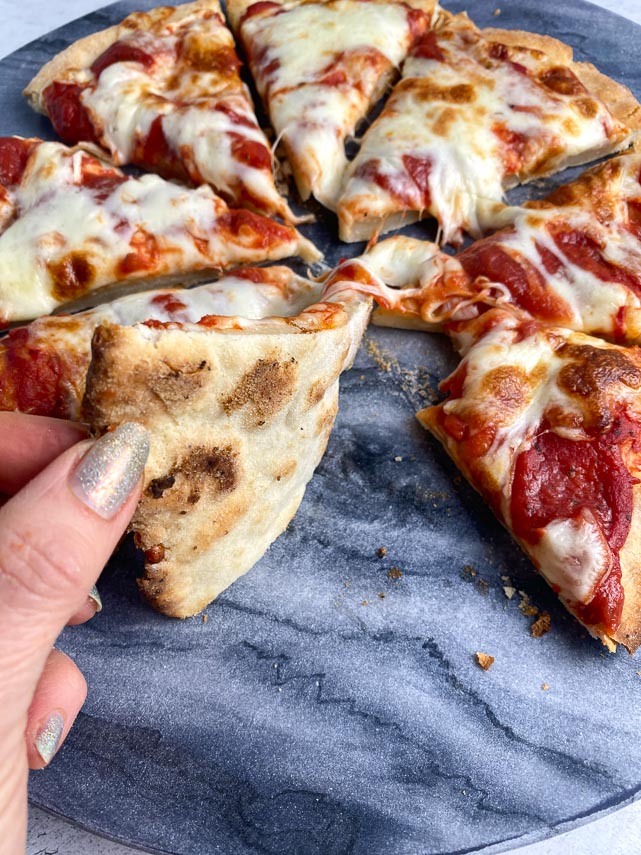
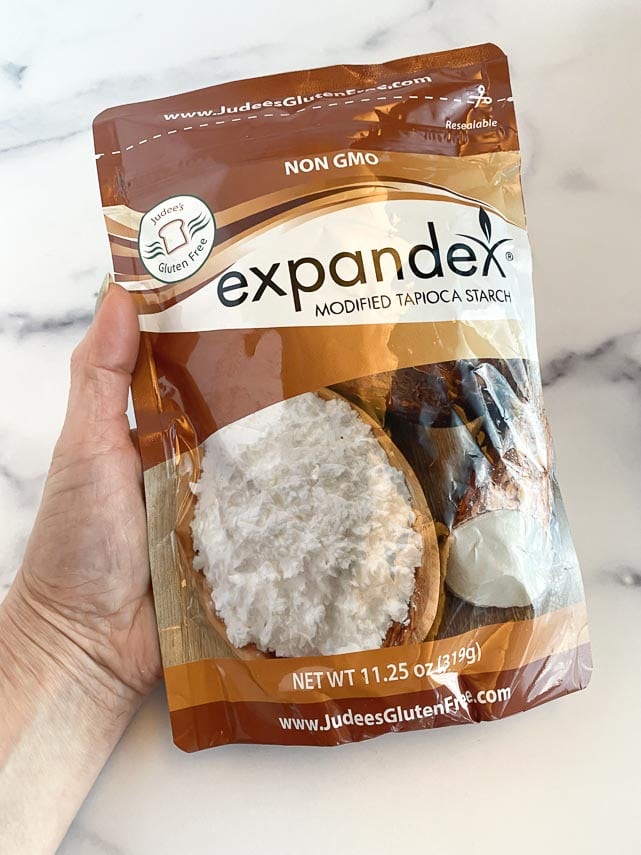
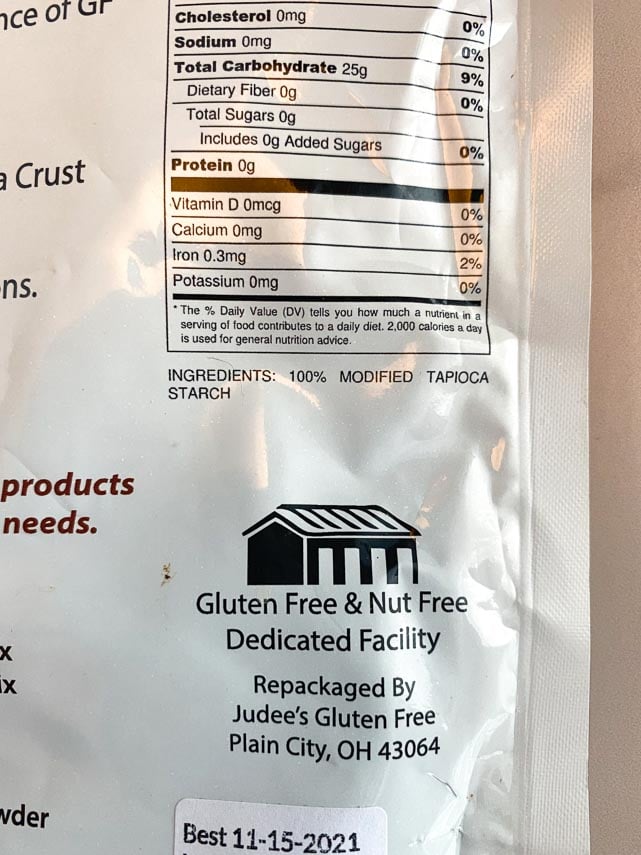
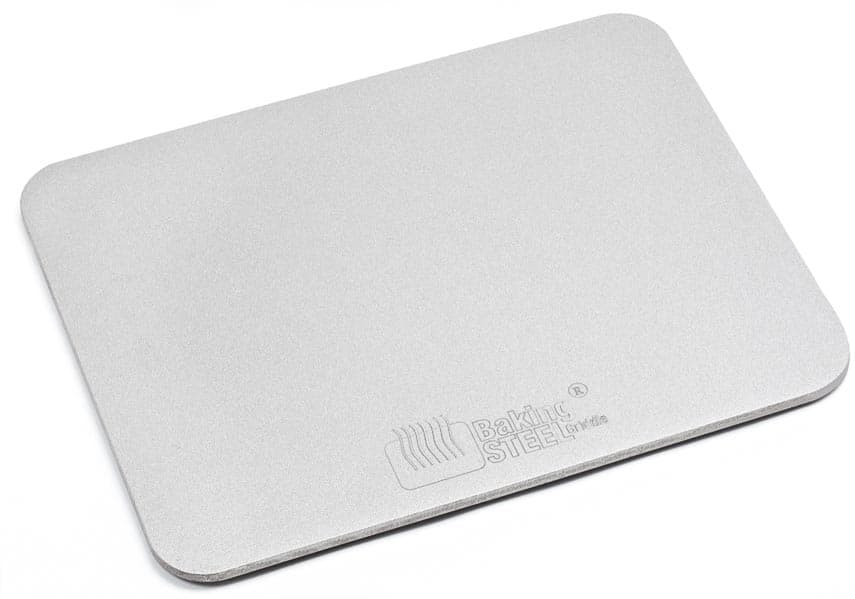
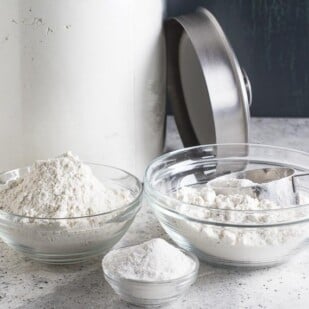
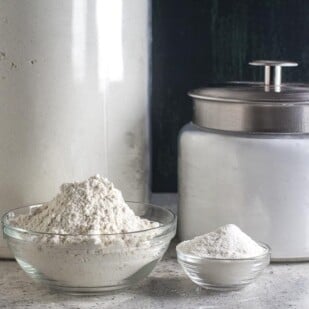




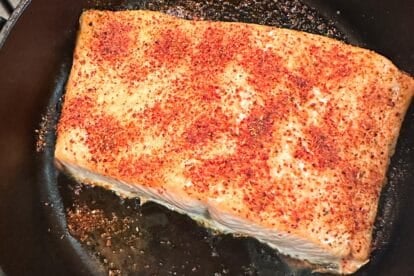
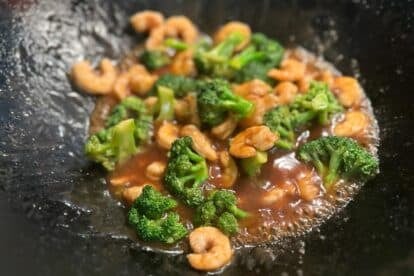
Thanks for the detailed pizza crust recipes. Although I think this one is a bit out of my reach, is there any reason you haven’t mentioned making either a) A pizza crust made with a gluten free blend (like LoFo) flour and yeast or lactose free yoghurt?? Im interested to know if this is something you’ve tried and didn’t turn out well?
Great question! I have reached out to LoFo serval times over the years to provide some samples to no avail. It is not a US product. As far as that approach with low FODMAP GF flours available here, the reason why I have not included such a recipe is because I have not thought the results to be good. You get a “base” but it is nothing like a pizza crust to my palate.